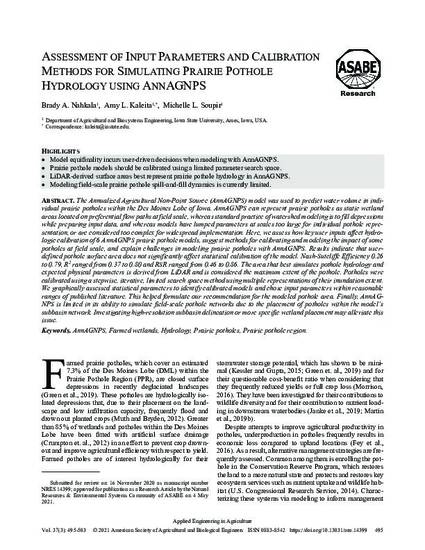
The Annualized Agricultural Non-Point Source (AnnAGNPS) model was used to predict water volume in individual prairie potholes within the Des Moines Lobe of Iowa. AnnAGNPS can represent prairie potholes as static wetland areas located on preferential flow paths at field scale, whereas standard practice of watershed modeling is to fill depressions while preparing input data, and whereas models have lumped parameters at scales too large for individual pothole representation, or are considered too complex for widespread implementation. Here, we assess how key user inputs affect hydrologic calibration of 6 AnnAGNPS prairie pothole models, suggest methods for calibrating and modeling the impact of some potholes at field scale, and explain challenges in modeling prairie potholes with AnnAGNPS. Results indicate that user-defined pothole surface area does not significantly affect statistical calibration of the model. Nash-Sutcliffe Efficiency 0.26 to 0.79, R2 ranged from 0.37 to 0.80 and RSR ranged from 0.46 to 0.86. The area that best simulates pothole hydrology and expected physical parameters is derived from LiDAR and is considered the maximum extent of the pothole. Potholes were calibrated using a stepwise, iterative, limited search space method using multiple representations of their inundation extent. We graphically assessed statistical parameters to identify calibrated models and chose input parameters within reasonable ranges of published literature. This helped formulate our recommendation for the modeled pothole area. Finally, AnnAGNPS is limited in its ability to simulate field-scale pothole networks due to the placement of potholes within the model‘s subbasin network. Investigating high-resolution subbasin delineation or more specific wetland placement may alleviate this issue.
Available at: http://works.bepress.com/michelle_soupir/96/

This article is published as Nahkala, Brady A., Amy L. Kaleita, and Michelle L. Soupir. "Assessment of Input Parameters and Calibration Methods for Simulating Prairie Pothole Hydrology using AnnAGNPS." Applied Engineering in Agriculture 37, no. 3 (2021): 495-503. DOI: 10.13031/aea.14399. Posted with permission.